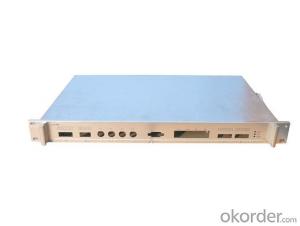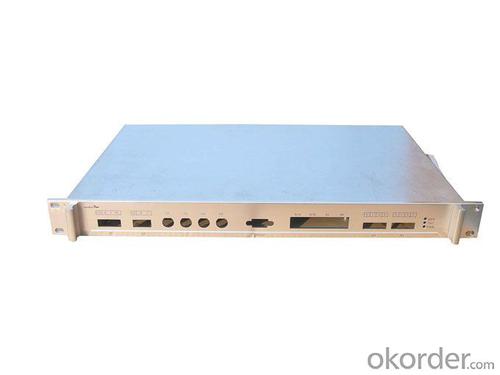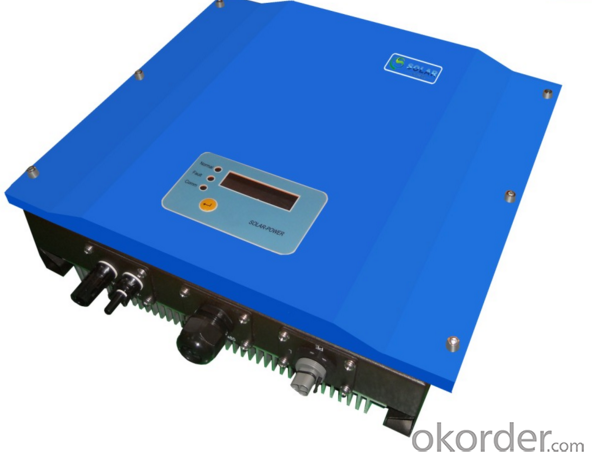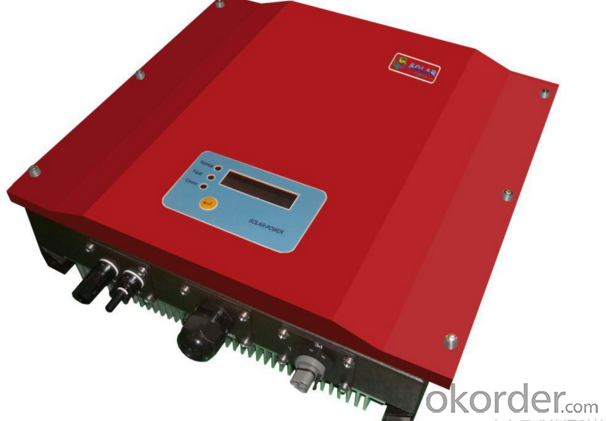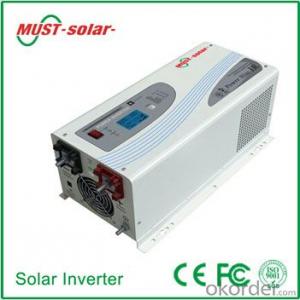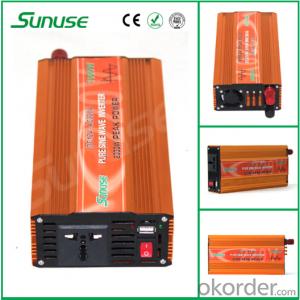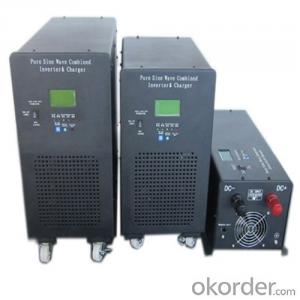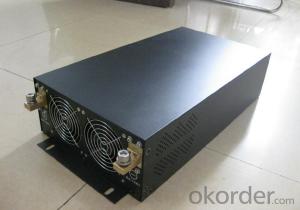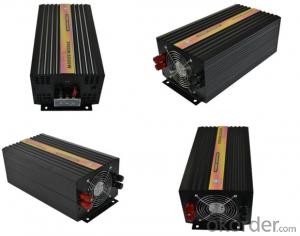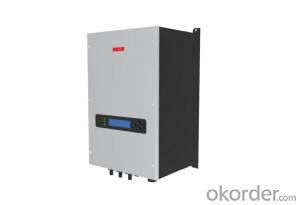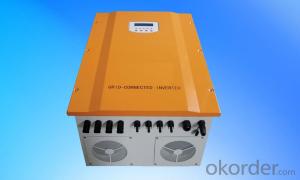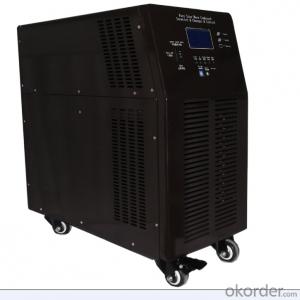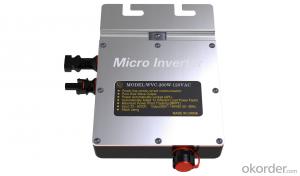Rich Solar Inverter - Single Phase Inverter Second Generation 4k Solar Inverter Made in China
- Loading Port:
- Shanghai
- Payment Terms:
- TT OR LC
- Min Order Qty:
- 0 watt
- Supply Capability:
- 10000 watt/month
OKorder Service Pledge
OKorder Financial Service
You Might Also Like
Description of Single Phase Inverter Second Generation 4k Solar Inverter
Solar ac power system consists of solar panels, charge controllers, inverter and battery; Solar energy does not include inverter dc power system. Inverter is a kind of power conversion device, inverter by incentives can be divided into self-excited oscillation inverter and separately excited oscillation inverter.
Features of Single Phase Inverter Second Generation 4k Solar Inverter
Standard 10 years warranty, 5-15 years optional
Built-in Gprs as option
Built-in Wifi as option
Smaller and lighter, only 9.6kg
High performance DSP for algorithm control
VDE-AR-N 4105 certification
New topology design
Dual MPPT design
Multi-button touch interface
LCD screen visible at night
Have anti-shading function
Advantages of Single Phase Inverter Second Generation 4k Solar Inverter
Longer life cycle
Plug and play
Free monitoring through our webportal
Very lower internal temperature
Easy transportation and installation
Faster CPU speed
Adjustable active and reactive power
Maximum conversion effciency up to 97.7%,Euro up to 96.9%
Real-time data readable at night
User friendly operation
Technical Data of Single Phase Inverter Second Generation 4k Solar Inverter
| Type | Omniksol-4k-TL2 |
| Input(DC) | |
| Max.PV Power | 4500W |
| Max,DC Voltage | 590V |
| Nominal DC Voltage | 360V |
| Operating MPPT Voltage Range | 120-550V |
| MPPT Voltage Range at Nominal Power | 150-500V |
| Start up DC Voltage | 150V |
| Turn off DC Voltage | 120V |
| Max, DC Current | 12A |
| Max, Short Cicuit Current for each MPPT | 16A |
| Number of MPP trackers | 2 |
| Max.Input Power for each MPPT | 2600W |
| Number of DC Connection for each MPPT | A:1/B:1 |
| DC Connection Type | MC4 connector |
| Output(AC) | |
| Max,AC Apparent Power | 4400VA |
| Nominal AC Power (cos phi = 1) | 4000W |
| Nominal Grid Voltage | 220V/230V/240V |
| Nominal Grid Frequency | 50Hz/60Hz |
| Max, AC Current | 19.0A |
| Grid Voltage Range** | 185-276V |
| Grid Frequency Range** | 45-55Hz/55-65Hz |
| Power Factor | 0.9 capacitive... 0.9 inductive |
| Total Harmonic Distortion(THD) | <2% |
| Feed in Starting Power | 30W |
| Night time Power Consumption | <1W |
| Standby Consumption | 6W |
| AC Connection Type | Plug-in connertor |
| Efficiency | |
| Max,Efficiency | 98.2% |
| Euro Efficiency | 97.5% |
| MPPT Efficiency | 99.9% |
| Safety and Protection | |
| DC Insulation Monitoring | Yes |
| DC Switch | Optional |
| Residual Current Monitoring Unit (RCMU) | Integrated |
| Grid Monitoring with Anti-islanding | Yes |
| Electricity Fuse Protection | Yes |
| Protection Class | Ⅰ(According to IEC 62103) |
| Overvoltage Category | PVⅡ/Mains Ⅲ(According to IEC 62109-1) |
| Reference Standard | |
| Safety Standard | EN 62109, AS/NZS 3100 |
| EMC Standard | EN 6100-6-1, EN 6100-6-2, EN 6100-6-3 EN 6100-6-4, EN 6100-3-2, EN 6100-3-3 |
| Grid Standard | VDE-AR-N4105. VDE-0126-1-1,G83/1,EN 50438,RD1699,CEI 0-21, AS4777,C10/C11 |
| Physical Structure | |
| Dimensions | 352x421x162.5mm |
| Weight | 16.5kg |
| Environmental Protection Rating | IP 65 (According to IEC 60529) |
| Cooling Concept | Internal fan convection |
| Mounting Information | Wall bracket |
| General Data | |
| Operating Temperature Range | -25℃ to +60℃(derating above 45℃) |
| Relative Humidity | 0% to 98%, no condensation |
| Max. Altitude (above sea level) | 2000m |
| Noise Type | <40dB |
| Isolation Type | Transformerless |
| Display | 3 LED ,Backlight, 4x20 Character LCD |
| Data Communication | RS485(WiFi, GRPS integrated) |
| Computer Communication | USB |
| Standard Warranty | 10 Years (5-15 years optional) |
IMages of Single Phase Inverter Second Generation 4k Solar Inverter

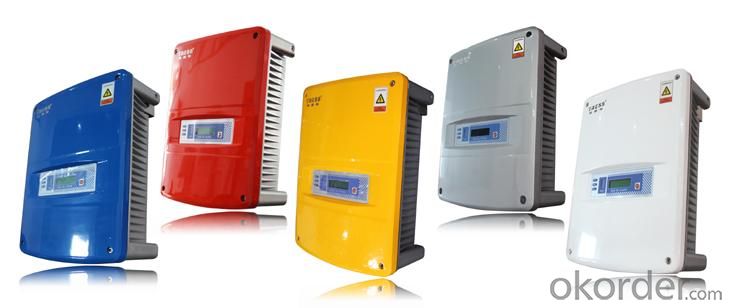
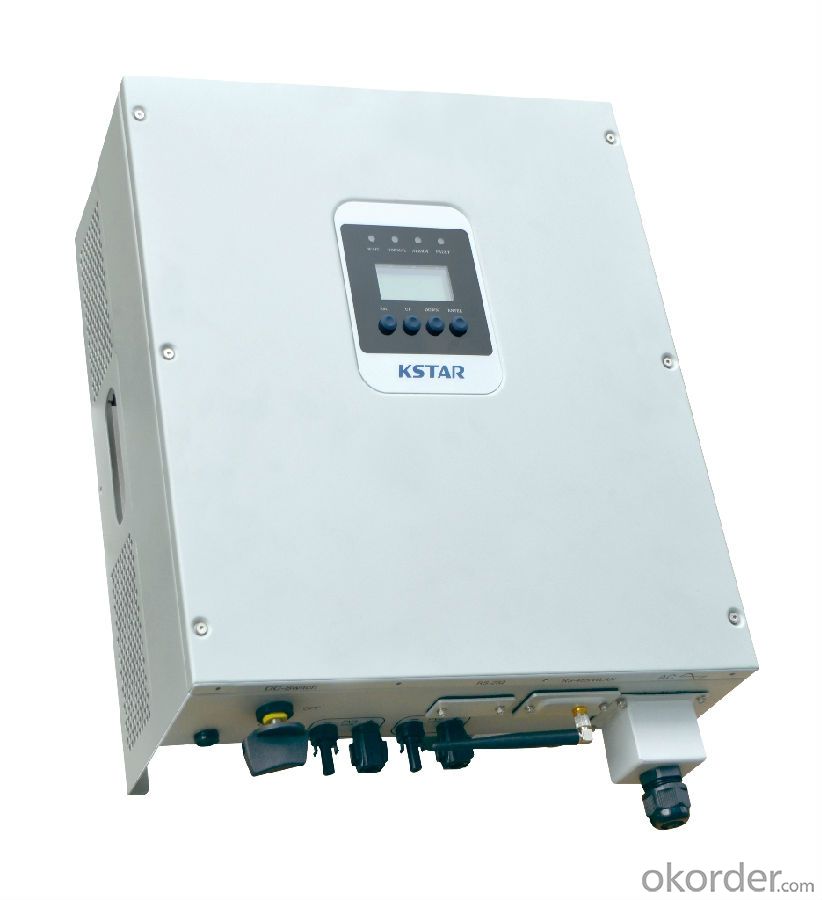
FAQ
Q: Do you have the CE, TUV, UL Certification?
A: We’ve already passed all the tests, and any certificate is available.
Q: Have you ever sold your products to companies in my country?
A: Of course, we have customers in all general PV markets, but I think we should expand our market share along with the market growth.
Q: When did your company set up? You are a new company, how can I believe your quality?
A: We entered into Solar PV industry in 2005, now we have several plants in manufacturing of a-Si and c-Si panels, and our capacity is 220MW per year. Till now we have already passed all the tests by authorized laboratories, e.g. TUV, CE, UL.
Q: Can you help us install the module if we cooperate with you?
A: We haven’t entered into installation sector, but we have the plan in near future.
Q: How do you pack your products?
A: We have rich experience on how to pack the panels to make sure the safety on shipment when it arrives at the destination.
Q: Can you do OEM for us?
A: Yes, we can.
Q: Can we visit your factory?
A: Surely, I will arrange the trip basing on your business schedule.
- Q: What are the indicators of a faulty solar inverter?
- Some indicators of a faulty solar inverter include a complete loss of power generation, inconsistent or fluctuating power output, unusual noises or smells coming from the inverter, error messages or warning lights on the display panel, and physical damage or overheating of the inverter unit.
- Q: Can a solar inverter convert DC power to AC power during a power outage?
- No, a solar inverter cannot convert DC power to AC power during a power outage. During a power outage, the solar inverter relies on the grid to function, and without grid power, it cannot convert DC power from the solar panels into usable AC power.
- Q: Can a solar inverter be used with solar-powered desalination systems?
- Yes, a solar inverter can be used with solar-powered desalination systems. A solar inverter is essential in converting the direct current (DC) power generated by solar panels into alternating current (AC) power that can be used to operate the desalination system. This allows for the efficient utilization of solar energy for powering the desalination process.
- Q: How does a solar inverter handle voltage fluctuations from the solar panels?
- A solar inverter handles voltage fluctuations from the solar panels by continuously monitoring the output voltage and adjusting it to maintain a stable and consistent level of voltage. It employs advanced control algorithms and power electronics to regulate and stabilize the voltage, ensuring optimal energy conversion and compatibility with the electrical grid. This helps protect the inverter and other connected devices from damage while maximizing the energy output from the solar panels.
- Q: What is the difference between a PV grid-connected inverter and an off-grid inverter?
- Off-grid inverter is equivalent to their own to establish an independent small power grid, mainly to control their own voltage, is a voltage source.
- Q: How does MPPT improve the performance of a solar inverter?
- MPPT (Maximum Power Point Tracking) improves the performance of a solar inverter by optimizing the power generated from the solar panels. It continuously adjusts the operating voltage and current to ensure that the solar panels are operating at their maximum power point, which is the point where they generate the most power. This allows the solar inverter to convert the maximum amount of solar energy into usable electricity, resulting in increased efficiency and improved overall performance.
- Q: What is the role of a solar inverter in power quality management?
- The role of a solar inverter in power quality management is to convert the direct current (DC) generated by solar panels into alternating current (AC) that can be used to power electrical devices. Additionally, solar inverters play a crucial role in managing and maintaining the quality of power supplied to the grid, ensuring it meets the required voltage and frequency standards. They help in mitigating issues like voltage fluctuations, harmonics, and power factor imbalances, thereby improving the overall power quality and stability of the electrical system.
- Q: Can a solar inverter be used in a mobile or portable solar power system?
- Yes, a solar inverter can be used in a mobile or portable solar power system. A solar inverter is responsible for converting the direct current (DC) generated by the solar panels into alternating current (AC) that can be used to power various devices. By incorporating a solar inverter into a mobile or portable solar power system, it becomes possible to harness solar energy and use it to power electronic devices while on the go. This makes it a convenient and sustainable option for providing electricity in remote locations or during outdoor activities.
- Q: What are the advantages of using a solar inverter with battery storage?
- The advantages of using a solar inverter with battery storage include: 1. Energy independence: With a solar inverter and battery storage system, you can generate, store, and use your own electricity, reducing your reliance on the grid and ensuring a continuous power supply even during grid outages. 2. Increased self-consumption: The battery storage allows you to store excess solar energy generated during the day for use at night or during cloudy days, maximizing self-consumption and reducing the need to purchase electricity from the grid. 3. Time-of-use optimization: By storing excess solar energy and using it during peak demand periods, you can take advantage of time-of-use pricing, where electricity rates are higher during peak times. This can help you save money on your electricity bills. 4. Backup power: During power outages, the battery storage system can provide backup power, ensuring that critical appliances or equipment continue to function. This is particularly beneficial for homes or businesses that require uninterrupted power supply. 5. Environmental benefits: Solar energy is a clean and renewable source of energy. By using a solar inverter with battery storage, you can reduce your carbon footprint and contribute to a greener future by minimizing reliance on fossil fuels. 6. Grid support and stability: Battery storage systems can also provide grid support services, such as frequency regulation and peak shaving. This helps to stabilize the grid and improve overall energy efficiency. Overall, using a solar inverter with battery storage offers numerous advantages, including energy independence, cost savings, environmental benefits, and improved reliability of power supply.
- Q: Can a solar inverter be used in remote areas without access to the grid?
- Yes, a solar inverter can be used in remote areas without access to the grid. Solar inverters are designed to convert the DC power generated by solar panels into AC power that can be used to run electrical appliances. In remote areas, where there is no grid connection, solar inverters can be used in off-grid or standalone systems to provide electricity for various purposes, such as lighting, charging batteries, or powering small appliances. These systems typically include solar panels, batteries for energy storage, and the solar inverter to convert the stored energy into usable AC power.
Send your message to us
Rich Solar Inverter - Single Phase Inverter Second Generation 4k Solar Inverter Made in China
- Loading Port:
- Shanghai
- Payment Terms:
- TT OR LC
- Min Order Qty:
- 0 watt
- Supply Capability:
- 10000 watt/month
OKorder Service Pledge
OKorder Financial Service
Similar products
Hot products
Hot Searches
Related keywords
